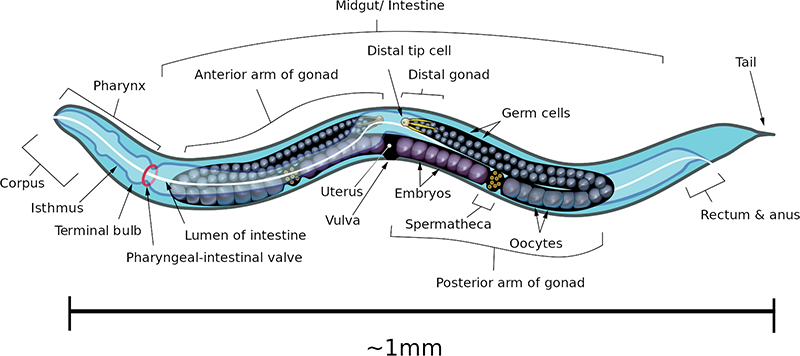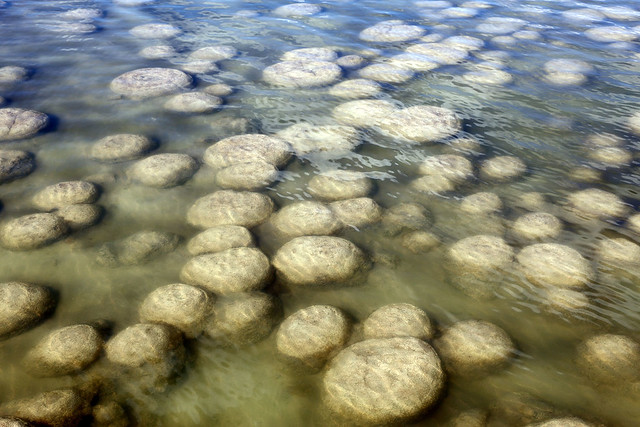

| Archive Blog Cast Forum RSS Books! Poll Results About Search Fan Art Podcast More Stuff Random |
|
Classic comic reruns every day
|
1 {photo of nematode worms}
1 Caption: Everywhere
|
First (1) | Previous (3366) | Next (3368) || Latest Rerun (2862) |
Latest New (5380) First 5 | Previous 5 | Next 5 | Latest 5 Annotations theme: First | Previous | Next | Latest || First 5 | Previous 5 | Next 5 | Latest 5 This strip's permanent URL: http://www.irregularwebcomic.net/3367.html
Annotations off: turn on
Annotations on: turn off
|
I ran across an interesting quotation the other day. Without further ado:
In short, if all the matter in the universe except the nematodes were swept away, our world would still be dimly recognizable, and if, as disembodied spirits, we could then investigate it, we should find its mountains, hills, vales, rivers, lakes, and oceans represented by a film of nematodes. The location of towns would be decipherable, since for every massing of human beings there would be a corresponding massing of certain nematodes. Trees would still stand in ghostly rows representing our streets and highways. The location of the various plants and animals would still be decipherable, and, had we sufficient knowledge, in many cases even their species could be determined by an examination of their erstwhile nematode parasites.
This was written by Nathan Cobb, a pre-eminent nematologist and founding director of the United States Department of Agriculture's Nematology Lab. The subject of Cobb's words, nematodes, are tiny worms which, as the quotation implies, are pretty much everywhere around us. A square metre of soil contains millions of them. Most nematode species are parasitic, meaning they live on or in other species.[1] Parasitologists estimate that over 50% of humans are infected with nematodes, and the infection rate of most other animals and also plants is probably significantly higher[2]. Over 12,000 species of nematodes are known to be capable of infecting humans.
 Microphotograph of C. elegans, a typical nematode. Creative Commons Attribution-Share Alike image, by Zeynep F. Altun from Wikimedia Commons. |
But many nematode species are are also free-living animals, and they occur pretty much everywhere: oceans, fresh water, within soils, on top of the highest mountains, in deserts, in the tropics, and in the polar regions. Biologists estimate that something like 80% of all the individual animals on Earth are nematodes, and that there are approximately a million different species of them.
Nematodes are small, thin worms with a round cross section. They have a simple tubular digestive system running the length of the body, from a mouth at the head end to an anus at the tail end. The smallest nematodes are microscopic, the largest free-living ones are a few centimetres long, while some parasitic species can grow to around a metre in length. They have a simple nervous system, and one species in particular, Caenorhabditis elegans, has had its entire nervous system including the connections between nerve cells mapped - the only animal species so far. C. elegans only has 302 neurons, so making the task tractable. In fact, typical specimens of C. elegans have only 959 cells in their entire body, and the complete path of development of each cell from a fertilised egg, through the cell divisions and differentiation into an adult animal has also been mapped. Which is pretty cool.
 Diagram showing structure of C. elegans, a typical nematode. Creative Commons Attribution-Share Alike image, by KDS444 from Wikimedia Commons. |
But the thing about nematodes that Cobb was building on with his quotation was the sheer ubiquity of nematodes. If you remove everything from the Earth except for the nematodes, then there will be a spherical shell of nematodes corresponding to the soil, rivers, and oceans of the world. Not only this, but there will be clusters of parasitic nematodes which define where the animals they infected lived. Which brings to mind a question pondered over a lunch break at work: What other things could you infer the locations of living things on Earth from if they were the only thing left behind?
The first answer we thought of is bacteria, which are even more numerous and widespread than nematodes (but are not animals, so don't figure into the above statement about nematodes comprising 80% of all animals). If you removed everything from Earth except the bacteria, you would have a similar ghostly Earth-sized bubble of bacteria to the nematodes. But it would be easier to determine the locations and shapes of former animals, as we all have billions of bacteria within our bodies. In fact, bacteriologists reckon that within a human body there are approximately 1013 human cells, but 1014 bacteria - ten times as many. We don't notice all these bacteria since they are much smaller than human body cells, but if you removed the human cells there'd be more than enough bacteria left over to define the shape of your body in some detail. In particular, your skin would be outlined, and there would be clumps of bacteria defining your mouth, digestive tract, and lungs. All together, this bacterial ghost comprises an estimated 1-3% of what you consider to be your body mass.[3]
 Thrombolites, produced by bacteria. |
The next thing I thought of was another thing which animals have within our bodies but isn't really a part of our bodies: urea. This compound is the major component of waste dissolved in urine, so there'll be a blob of it in the bladder region of terrestrial vertebrate animals. Reading a bit about it, urea is also part of a cycle of nitrogen compounds in many species, including fish, invertebrates, plants, and fungi. So there will be concentrations of urea left over wherever life is removed from our ghost Earth. Interestingly, there will also be concentrations of urea left in many human industrial and agricultural settings, since the compound is used for fertiliser and explosives, as well as several other things.
What came to mind next were other biological compounds, such as haemoglobin, or even DNA, which would obviously trace the positions of living organisms if left behind. In a sense, these are cheating a little bit, as there are any number of biological molecules we could name which would result in a similar set of leftovers after everything else is gone.
Then someone mentioned water, which is interesting. Leaving all the water on Earth while removing everything else would produce most obviously a partial shell made of the oceans and icecaps, plus a spidery web of rivers floating above the formerly underground water table. But once you get close enough to resolve smaller details, you'll see ghostly water clouds of living creatures and plants all over the place. A human body is roughly two-thirds water by volume, so most of you would actually be left behind. And it would look pretty cool, too.
Leaving water behind would also leave interesting traces of our technology. Think of all the machines and appliances that have water in them, from car cooling systems, to air conditioners, to coffee machines, to citywide plumbing and sewerage. Imagine what looking at the remains of a city would be like.
You could probably even see millions of nematodes everywhere.
[1] And obtain their nourishment from or is otherwise detrimental to those host species. An organism which lives on or in another species but is not detrimental to it is better described as an epibiont or a commensal symbiont.
[2] Reference: Stepek, G., Buttle, D. J., Duce, I. R. and Behnke, J. M. (2006), Human gastrointestinal nematode infections: are new control methods required? International Journal of Experimental Pathology, 87: 325-341. DOI: 10.1111/j.1365-2613.2006.00495.x
[3] So if you're keen to lose a bit of weight, simply subtract a kilo or two from what the scales say, since that's about the mass of the bacteria you're carrying around.
|
LEGO® is a registered trademark of the LEGO Group of companies,
which does not sponsor, authorise, or endorse this site. This material is presented in accordance with the LEGO® Fair Play Guidelines. |